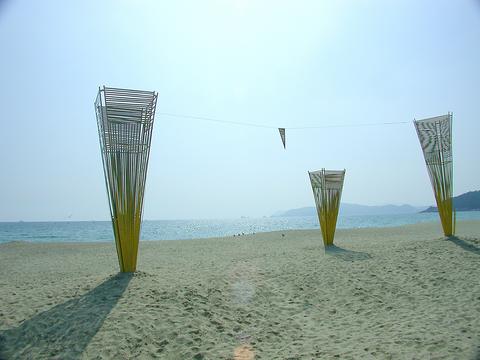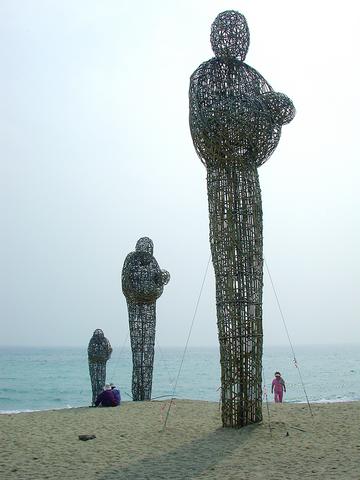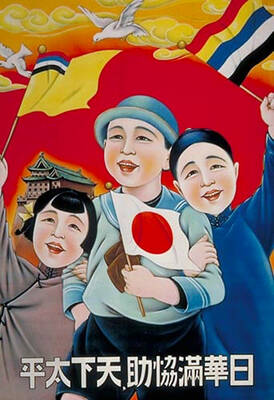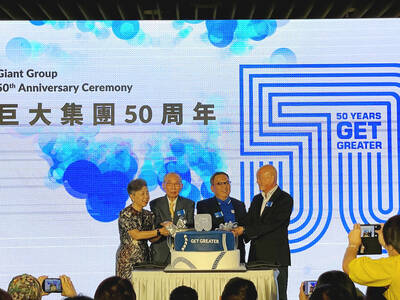Taiwan's contributions to the Busan Biennale in South Korea are either tucked away in a distant corner or illuminate one of the main gallery spaces, which was likely unintended but nevertheless seems appropriate.
Striving for exposure but not ignored, Taiwan's artists do not have to exhibit under the guise "Chinese Taipei" -- as do Taiwan's athletes playing in the concurrent Asian Games -- but their collective voice is barely heard in the international arts sphere.
Though South Korea's circumstances are different from those of Tawan, it is reasonable to presume that if it hosted genuinely international art exhibitions, or sports competitions like the Asian Games, then Taiwan's voice might be heard a little louder.

PHOTOS: JULES QUARTLY, TAIPEI TIMES
"Culture meets culture" is the theme of the collection of international art that has been gathered in Busan. It comprises a contemporary exhibition, a sea art festival, a sculpture project and various "guerilla artfare" performances that occur throughout the city at various times.
"Artists were chosen from various countries because the curators thought their work represented urbanity and the city is where cultures meet and coexist," said one of the Biennale's coordinators Kwon Ki-hyun.
"They were commissioned to produce a work of art for us and we encouraged them to come to Busan so it could be about our city. As a result, we now have a volume of art that is dedicated to it."

Other works, Kwon said, were borrowed from collections because they were thought to represent a particular notion of metropolis that was universal to all cities.
Taiwanese artist Yuan Guang-ming's contribution is in this category. Placed in a hard-to-find recess of the Busan Metropolitan Art Museum, the his looped black and white film pans very slowly across an empty street corner of Hsimenting, Taipei. The rhetorical question the artist poses is, "If all the movements in the crowded city are removed, what can one expect?"
It does not take a genius to present this: Shades of concrete gray enlivened only by the white markings of a zebra crossing and detritus. Some people looked in, stared, waited for something to happen and left.
More lively and inspiring were the works of artists, such as South Korea's Jung Yeon-doo, who recreates a dancehall within the museum, complete with blinking lights and snapshots of couples dancing on the walls. His aim is to renew one's perception of cabaret culture.
Taiwan's Hung Tung-lu looks at the city through comic book and computer game lenses. His saturated holographic images of X-men or women in fighting stances pose in front of traditional Chinese monuments, surrounded by dense fields of chocolate box-like flowers. Asura, or "state of frenzy," appears to depict an attack by spacecraft on a US city that looks like New York. Finished before 911, Hung's take is that "images get ahead of reality."
Whatever. The best part of the Biennale is that it gets out of the museum, onto the street -- and in this case, the beach -- and away from the artists' explanations of their own works or the critics' interpretations.
There is pleasure rather than debate in seeing giant statues of split and tied cane men rising out of the sands and toward the sea on Haeundae Beach, such as Choi Pyung-gon's For a Baby. Frankly, the artist's claim that these figures represent young children in an Afghanistan refugee camp are ludicrous.
A collective of Busan artists has built a stretch Cadillac with sails and anyone can climb into the driver's seat and imagine driving across the ocean. The Spirit of Pioneers, by another South Korean group, is a full-size train rising out of the sand and over the sea.
Children wonder at these images, tourists are impressed and at night, lovers take a bottle of soju stroll around to enjoy these unusual and sometimes inspiring sights.

In recent weeks the Trump Administration has been demanding that Taiwan transfer half of its chip manufacturing to the US. In an interview with NewsNation, US Secretary of Commerce Howard Lutnick said that the US would need 50 percent of domestic chip production to protect Taiwan. He stated, discussing Taiwan’s chip production: “My argument to them was, well, if you have 95 percent, how am I gonna get it to protect you? You’re going to put it on a plane? You’re going to put it on a boat?” The stench of the Trump Administration’s mafia-style notions of “protection” was strong

Oct. 6 to Oct. 12 The lavish 1935 Taiwan Expo drew dignitaries from across the globe, but one of them wasn’t a foreigner — he was a Taiwanese making a triumphant homecoming. After decades in China, Hsieh Chieh-shih (謝介石) rose to prominence in 1932 as the foreign minister for the newly-formed Japanese puppet state of Manchukuo in today’s Northeast China. As ambassador to Japan, he was to represent the last Qing emperor Puyi (溥儀) at the event’s Manchuria Pavillion, and Taiwan’s governor-general welcomed him with the honors of a state guest. Hsieh also had personal matters to attend to — most

Late last month US authorities used allegations of forced labor at bicycle manufacturer Giant Group (巨大集團) to block imports from the firm. CNN reported: “Giant, the world’s largest bike manufacturer, on Thursday warned of delays to shipments to the United States after American customs officials announced a surprise ban on imports over unspecified forced labor accusations.” The order to stop shipments, from the US Customs and Border Protection (CBP), came as a surprise to Giant, company officials said. Giant spokesman Ken Li (李書耕) said that the CPB never visited the company’s factories to conduct on-site investigations, nor to interview or

The Korea Times announced the results of K-universities Global Excellence Rankings 2026, the nation’s first comprehensive assessment of global performance across its universities. The evaluation was launched to provide an objective analysis of the globalization status of Korean universities and to offer practical guidance for international students choosing institutions in South Korea. KOREA UNIVERSITY RANKS FIRST In the overall rankings, Korea University secured first place with a total score of 144.86, followed by Seoul National University (141.48) and Yonsei University (140.33). Rounding out the Top 10 were Sungkyunkwan University (132.20), Hanyang University (124.83), Sogang University (112.27), University of Seoul (111.10), Ewha Womans